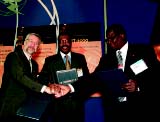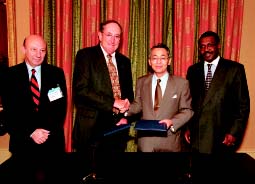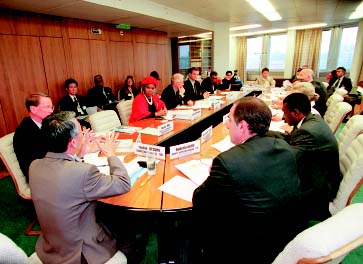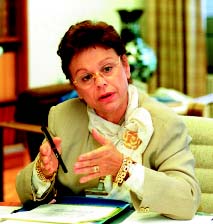
From left to right: Messrs A. Biston, H. Touré and G. Zongo
(ITU 990109)
The ITU has signed a major agreement with Nortel Networks and the Acacia Initiative of the International Development Research Centre of Canada to implement two Centres of Excellence in Africa. This agreement follows the announcement made in June 1999 to support ITU's Centres of Excellence Programme (see ITU News, No. 7/99, pages 44–46).

From left to right: Messrs A. Biston, H. Touré and G. Zongo
(ITU 990109)
|
"Rural connectivity is a major challenge because it involves installing complex telecommunications equipment to serve only small islands of subscribers in remote areas. With PicoNode systems available at the Centres of Excellence, African telecommunication managers can learn how to cost-effectively adapt GSM technology to fit specific market conditions." — Alain Biston, Vice-President, Wireless Solutions, Middle East and Africa, Nortel Networks. "Africa represents a large market which is still too often hampered by the world's highest costs, critical skills shortages and stymied policies that, together, foil teledensity goals and adequate infrastructure. Partnership agreements such as the one signed with Nortel Networks and the Acacia Initiative can be major factors in helping the countries of the region unleash their full potential for the benefit of the 500 million Africans living in rural or remote areas. This new form of cooperation is one of the promising ways to boost telecommunication development where traditional mechanisms did not yield results and should send strong signals to the industry on the way forward." — Hamadoun Touré, Director, Telecommunication Development Bureau. "Universal access is the main concern of African policy makers today. Building capacity through these Centres of Excellence will enable African policy and decision makers to adopt strategies which will allow the use of information and communication technologies in order to deliver critical services such as education, health care and e-commerce." — Gaston Zongo, Executive Director of Acacia. |
Under the terms of the agreement, the three parties will invest some USD 3.6 million to enable the two African Centres of Excellence located in Nairobi and Dakar, to start operations immediately.
As a principal private sector partner in the project, Nortel Networks will contribute more than USD 1 million over the next three years including training materials and support. In addition, the company will provide a GSM cellular PicoNode system to each centre. This system, which is slightly larger than a per- sonal computer, can deliver basic voice services to a community of 100 to 1000 end-users.
The International Telecommunications Satellite Organization (INTELSAT) and ITU signed a Memorandum of Understanding (MoU) to promote and develop universal access in rural and isolated areas. The MoU establishes a framework for cooperation, which will encourage other leaders in the communications industry worldwide to join these efforts.
In the year 2000, both parties will develop a cooperative programme to assess the technical and financial needs of rural and isolated areas and will recommend satellite-based pilot programmes to develop a communications infrastructure.
The MoU will be implemented by the Telecommunication Development Bureau in cooperation with INTELSAT.

From left to right: Messrs Milenko Stojkovic, Director, Telecommunica-tions Policies and Regulatory Affairs
(INTELSAT), L. Dooley, Y. Utsumi and H. Touré
(ITU 990110)
|
"Wireless technologies have a tremendous potential to extend access to remote and under-served rural areas. In addition to policy and regulatory incentives that can boost the supply of telecommunications, technologies can help, particularly in areas where it is difficult to attract investment. ITU is pleased to be able to cooperate with INTELSAT in bringing the benefits of telecommunications to large tracks of the world's population living outside main urban centres." — Yoshio Utsumi, ITU Secretary-General. "The ITU has a vision and commitment to make universal access a reality in as short a timescale as possible. I want all areas of the world to rapidly have access to modern communications facilities and services and benefit in a tangible and sustainable manner from the econ- omic benefits that such access can bring. I believe that the MoU will help us progress in achieving these goals." — Hamadoun Touré, Director, Telecommunication Development Bureau. "As we meet in Geneva [Telecom 99] to showcase history's most advanced technologies for voice, data and the Internet, we need to remember that three-fifths of the world's population is still without the most basic means of communications. We are pleased to be able to work with ITU in our mission to close this 'information gap', and believe that satellites provide the best solution for these regions." — Leonard Dooley, INTELSAT Vice-President, External Affairs. |
| * These partnership agreements were signed at Telecom 99. |
The reform process was set in motion by the last Plenipotentiary Conference (Minneapolis, 1998) when deciding to review and improve the management, functioning and structure of the International Telecommunication Union.
It was recognized that ITU is entering a new era where the world is witnessing many forces of change:

Yoshio Utsumi explaining the complexity of ITU's structure and functioning
(ITU 990107)
These changes are creating new needs for ITU Members, and new expectations. Among other things:
Pursuing the objectives of Resolution 74 (Minneapolis, 1998) with a view to drawing up a report to the Council on how the organization should be redesigned to better serve the needs of its government and private Sector Members, major telecommunication users, consumers and other members of the international community, ITU Secretary-General, Yoshio Utsumi, set up a Reform Advisory Panel (RAP) to seek the advice of leaders from industry and governments around the world.
Ministers and chief executive officers from major international corporations and representatives of industry associations have responded to the Secretary-General's invitation and joined the panel. RAP held its first meeting on 13 October 1999.
Mr Utsumi, who opened this meeting chaired by Maria Livanos Cattaui, Secretary-General of the International Chamber of Commerce (ICC), explained the complexity of ITU's structure and functioning. He stressed five key challenges which will need to be considered throughout the reform process. These challenges were indeed identified in the Secretary-General's "State of the Union address" to the Council in June this year (see ITU News, No. 6/99, pages 1–3). In a nutshell, ITU needs to:

Maria Livanos Cattaui (UIT 990108)
Having noted these challenges, RAP members engaged in a frank discussion focusing on the points highlighted below.
The Union has an almost universal membership ? 189 Member States and more than 580 Sector Members. It serves as a neutral, credible and global body bringing order in the telecommunication environment where the rapid pace of change in markets has become a most dynamic issue.
It has functioned well for many years in developing global standards and managing allocation of the frequency spectrum, according to the needs and/or requirements of its membership. Cyclical Telecom events are also a useful forum for raising awareness of the public sector. The Union should build on these strengths to help reduce the gap in the information society.
Faced with the rapid pace of change in telecommunications, the results of the 1992 restructuring and 1998 Plenipotentiary Conference were disappointing and insufficient. Some panel members believe that the lack of an effective ITU presence in major debates actually shaping the industry is a serious weakness. For example, ITU was absent from many of the negotiations that led to the World Trade Organization (WTO) Basic Telecommunication Agreement.
The Internet is here and debates on key issues are already taking place in other forums, for example the Organization for Economic Co-operation and Development (OECD), the World Intellectual Property Organization (WIPO) and the Asia-Pacific Economic Cooperation (APEC). Another weakness is the lack of an adequate mechanism to enforce rules and obligations adopted within ITU. It was also felt that some of the most important players were not represented on the Council and have no decision-making role. The ITU decision-making process, which has been based on consensus-building, has to be reviewed in the light of new realities and the need for quick action.
As a truly global body, ITU must take the lead role in managing and facilitating the transition to open and competitive markets. This will require greater involvement in the activities of the Union on the part of industry and regulators as well as other players.
Private sector dialogue should be encouraged and ITU should work to establish "better practices" that can serve as principles to guide the telecommunication sector. Information on reviews of good and bad practices in different areas of telecommunications should be circulated widely.
The Union should also develop mechanisms to resolve disputes and to enforce its rules and obligations.
At the same time, ITU should seek to maximize the benefits of convergence by paying more attention to the needs of the developing world, including the right to have access to communication networks. Private sector participation should be widely associated with development activities.
The Union should focus on the impact of the Internet on telecommunications and should coordinate its efforts with other international organizations that are active in this area.
The Union must move to an organizational model that allows for more rapid decision-making by its membership and should increasingly use public-private collaboration as a means to develop new rules. The role of the private sector in the decision-making process must be expanded and new players in the industry should be encouraged to become part of the ITU process.
Since the nature of the telecommunication industry is changing radically, the Union must break away from tradition. It must be "mean and lean" and eliminate bureaucracy. The weaknesses of the ITU's current structure (federal structure, number of elected officials, election process) should be addressed with a view to simplicity and increased efficiency and effectiveness. The Union must also do a better job to promote itself and to communicate its existence and role more effectively to the world.
RAP members will continue to exchange ideas and opinions and develop recommendations on ITU reform at their second meeting early in 2000.
The Fantastic Corporation (Zug, Switzerland) has been admitted to take part in the work of this Sector.
NTT Communications Corporation (NTT Communications) (Tokyo) has been admitted to take part in the work of this Sector as from 1 January 2000.
Catena Technologies, Inc. (Kanata, Ontario, Canada) and Philips GmbH Forschungslaboratorien Aachen (Aachen, Germany) has been admitted to take part in the work of this Sector.
GlobeSpan Technologies, Inc., which participates in the work of the Standardization Sector has changed its name. The new denomination is: GlobeSpan, Inc.
MCI International Inc., which participates in the work of the Development Sector has changed its name. The new denomination is: MCI WorldCom.
Nera ASA which participates in the work of the Radiocommunication Sector has changed its name. The new denomination is: Nera Network AS.
NTT Worldwide Network Corporation (NTT-WN), which participates in the work of the Standardization Sector has changed its name. The new denomination is: NTT Communications Corporation (NTT Communications).
Pirelli Telecom Systems Group, which participates in the work of the Standardization Sector has changed its name. The new denomination is: Pirelli Optical Systems, North America, Inc.
Circular letters (via facsimile) which have been sent to all Member States and Sector Members of the Union announces the following vacancy:
Detailed applications with ITU personal history form should be submitted to the General Secretariat of the ITU, Place des Nations, CH–1211 Geneva 20 (Switzerland), no later than the final dates mentioned above.
Vacancy notices and personal history forms are available on the ITU Web site, under the "ITU General Secretariat" section: http://www.itu.int/.
In issue No. 9/99 of ITU News, page 20, the photo caption should read: "Hand over of the symbolic key to the Secretary-General by Arthur Wettstein, CEO, Karl Steiner SA".
|
The following letters indicate the languages in which documents are published: F for French E for English S for Spanish R for Russian C for Chinese A for Arabic Prices are in Swiss francs (CHF). A comprehensive list of all the publications of the Union will be supplied, free of
charge, from the ITU Sales and Marketing Service, Place des Nations, CH-1211 Geneva 20 (Switzerland). |
Handbook on computer-aided techniques for spectrum management (1999)
(92-61-08021-9)
Separate editions in F, E, S (CHF 46)
Handbook on HF broadcasting system design (1999)
(92-61-06651-8)
Separate editions in F, E, S (CHF 28)
Telecommunication Standardization Sector
ITU–T Recommendation G.708 (06/99)
Sub STM-0 network node interface for the synchronous digital hierarchy (SDH)
Separate editions in F, E, S (CHF 12)
ITU–T Recommendation G.841 (10/98)
Types and characteristics of SDH network protection architectures
Separate editions in F, E, S (CHF 61)
ITU–T Recommendation G.852.2 (03/99)
Enterprise viewpoint description of transport network resource model
Separate editions in F, E, S (CHF 22)
ITU–T Recommendation G.852.3 (03/99)
Enterprise viewpoint for topology management
Separate editions in F, E, S (CHF 12)
ITU–T Recommendation G.852.8 (03/99)
Enterprise viewpoint for pre-provisioned adaptation management
Separate editions in F, E, S (CHF 9)
ITU–T Recommendation G.853.8 (03/99)
Information viewpoint for pre-provisioned adaptation management
Separate editions in F, E, S (CHF 12)
ITU–T Recommendation G.854.3 (03/99)
Computational viewpoint for topology management
Separate editions in F, E, S (CHF 17)
ITU–T Recommendation G.854.12 (03/99)
Computational viewpoint for pre-provisioned link management
Separate editions in F, E, S (CHF 12)
ITU–T Recommendation G.855.1 (03/99)
GDMO engineering viewpoint for the generic network level model
Separate editions in F, E, S (CHF 17)
ITU–T Recommendation G.872 (02/99)
Architecture of optical transport networks
Separate editions in F, E, S (CHF 22)
ITU–T Recommendation I.432.2 (02/99)
B-ISDN user-network interface — Physical layer specification: 155 520 kbit/s and 622 080 kbit/s operation
Separate editions in F, E, S (CHF 22)
ITU–T Recommendation Q.825 (06/98)
Specification of TMN applications at the Q3 interface: Call detail recording
Separate editions in F, E, S (CHF 39)
ITU–T Recommendation Q.832.2 (03/99)
VB5.2 Management
Separate editions in F, E, S (CHF 22)
ITU–T Recommendation Q.1701 (03/99)
Framework for IMT-2000 networks
Separate editions in F, E, S (CHF 17)
ITU–T Recommendation Q.1711 (03/99)
Network functional model for IMT-2000
Separate editions in F, E, S (CHF 29)
ITU–T Recommendation X.263 (09/98)
Information technology — Protocol identification in the Network Layer
Separate editions in F, E, S (CHF 17)
ITU–T Recommendation X.605 (09/98)
Information technology — Enhanced Communications Transport Service definition
Separate editions in F, E, S (CHF 22)
ITU–T Recommendation X.743 (06/98)
Information technology — Open Systems Interconnection — Systems Management: Time management function
Separate editions in F, E, S (CHF 39)
|
CONDITIONS OF SALE The ITU sells its publications on a non-profit basis. The prices quoted include packing costs and carriage by surface mail. All publications ordered from the ITU must be paid for in advance. Methods of payment Payments should be made in CHF:
Payments may also be made in other currencies, freely convertible into CHF, provided that, when converted by the bank, the price of the service in CHF is covered. The ITU does not accept letters of credit. Orders and cheques should be made to: International Telecommunication Union Tel.: +41 22 730 61 41 Fax: +41 22 730 51 94 Telex: 421 000 uit ch Tg: Buinterna Geneva X.400: S=sales; P=itu; A=400net; C=ch Internet: sales@itu.int A bookstall is open at ITU headquarters in Geneva from 08h30 to 12h00 and from 13h30 to 17h00. |